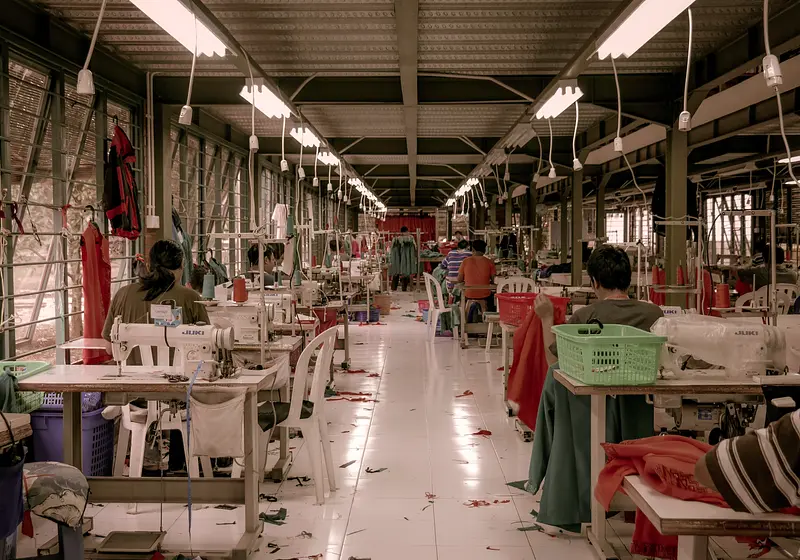In a world marked by rapid industrialization and ever-changing consumer demands, the fashion industry has emerged as both a creative force and an environmental challenge. The quest for the latest trends has often come at a cost to our planet, as traditional fashion practices contribute to pollution, waste, and ethical concerns. This article explores the impact of sustainable fashion on the environment, society, and biodiversity as a whole, and how teenagers can play a role in fostering positive change.
Let us slide into your dms 🥰
Get notified of top trending articles like this one every week! (we won't spam you)Impact on Environment
The environmental toll of unsustainable fashion is a reminder of the far-reaching consequences of our consumer choices. The fashion industry's insatiable appetite for resources, coupled with its inefficient production processes, casts a long shadow over the planet's fragile ecosystems.

Ogleznev From Pexels
Water Intensive Crop Cultivation: The cultivation of materials like cotton, a staple of the fashion industry, exemplifies the excessive water consumption that plagues unsustainable fashion. Cotton is a notoriously thirsty crop, requiring vast amounts of water to grow. In regions already grappling with water scarcity, the strain is even more acute.
Rivers run dry, aquifers deplete, and ecosystems suffer as water is diverted for the cultivation of fashion's raw materials. This depletion of vital water sources not only threatens local communities but also disrupts delicate aquatic ecosystems and exacerbates the global water crisis.
Energy-Hungry Manufacturing: The energy footprint of traditional fashion manufacturing is a significant contributor to its environmental toll. The processes involved in transforming raw materials into finished garments demand substantial energy inputs, often derived from fossil fuels.
From spinning and weaving to dyeing and finishing, each step releases greenhouse gases into the atmosphere, further accelerating climate change. The cumulative effect of these energy-intensive processes is a substantial carbon footprint that contributes to global warming and its far-reaching consequences.
Pollution and Deforestation: Unsustainable fashion's quest for raw materials often leads to pollution and deforestation. The chemicals used in dyeing and finishing textiles can contaminate water bodies, harming aquatic life and endangering human health. Additionally, the clearing of land for cotton cultivation and other materials contributes to deforestation, robbing wildlife of habitat and disrupting crucial ecosystems. This loss of biodiversity weakens the Earth's natural resilience and further imperils the delicate balance of nature.
Greenhouse Gas Emissions: The fashion industry's unbridled consumption of resources and energy translates directly into substantial greenhouse gas emissions. These emissions, primarily in the form of carbon dioxide and methane, trap heat in the atmosphere, driving climate change and its associated impacts.
As temperatures rise, weather patterns become erratic, sea levels creep higher, and extreme events become more frequent and intense. Unsustainable fashion thus contributes to a cycle of environmental degradation that jeopardizes the well-being of both present and future generations.
Take the Quiz: Which Indian city is the perfect holiday spot for you!?
Let's match you with an Indian city that you would love!
Impact On Society
The fast fashion phenomenon is a reflection of the modern consumer culture, where speed and convenience often overshadow the long-term consequences of our choices. This pervasive trend, while seemingly harmless on the surface, carries a host of negative impacts that ripple through our societies.

Teoh From Pexels
Culture of Disposability: At the heart of fast fashion lies a culture of disposability. The allure of constantly changing styles and dirt-cheap prices encourages consumers to perceive clothing as transient commodities rather than enduring investments. Garments, once coveted and worn only a handful of times, quickly lose their appeal and find themselves relegated to the back of closets or, worse yet, tossed into overflowing landfills.
The result is an alarming excess of textile waste that depletes natural resources and pollutes the environment. As landfills swell and incinerators burn, the true cost of our throwaway mentality becomes painfully evident.
Mounting Waste Crisis: The rapid turnover of fashion trends directly contributes to the mounting waste crisis that threatens our ecosystems. Many fast fashion items are constructed using synthetic materials that take hundreds of years to decompose, clogging landfills and emitting harmful pollutants as they break down.
This waste not only tarnishes the visual landscape but also leaches toxins into the soil and water, posing health risks to both humans and wildlife. The waste crisis perpetuated by fast fashion epitomizes the linear "take-make-dispose" model that is incompatible with a sustainable future.
Exploitative Labor Practices: The dark underbelly of the fast fashion industry extends beyond environmental concerns to encompass ethical and social issues. The relentless demand for ever-cheaper garments drives brands to seek low-cost labor in developing countries where regulations may be lax and workers' rights are often ignored.
The result is a cycle of exploitation where workers, typically women, endure abysmal wages, hazardous working conditions, and limited job security. This exploitation leaves them trapped in a cycle of poverty, unable to escape the grasp of unfair labor practices.
Human Impact: The impact of exploitative labor practices is not confined to economic disparities. Unsafe working conditions and lack of job security expose workers to physical and emotional harm. As they toil in cramped, unsafe factories for long hours, they often face health risks, from exposure to harmful chemicals to stress-related ailments. The exploitation of workers for the sake of fast fashion stands as a stark reminder of the human toll that underlies our insatiable appetite for cheap, disposable clothing.
Impact On Biodiversity
The impact of unsustainable fashion on biodiversity loss is a less visible but equally critical facet of the industry's ecological footprint. The intricate tapestry of life on Earth, woven together by countless species and ecosystems, faces disruption and degradation due to the fashion industry's reliance on conventional farming practices and the use of harmful chemicals.

Ingelrest From Pexels
Pesticides and Synthetic Materials: Conventional farming practices, often used to cultivate the raw materials for clothing, lean heavily on synthetic pesticides and fertilizers. These chemicals, while designed to enhance yields and protect crops, inadvertently disrupt the balance of ecosystems.
Pesticides seep into the soil and water, contaminating the food chain and affecting not just targeted pests, but also non-target organisms essential for ecosystem health. Birds, insects, aquatic life, and even soil microorganisms fall victim to these toxic substances, disrupting the delicate relationships that sustain life.
Disruption of Ecosystems: Unsustainable fashion's contribution to biodiversity loss is intricately linked to the disruption of ecosystems. Ecosystems are complex networks of living organisms and their environments, interwoven in a delicate dance of coexistence. Conventional farming practices strip away this delicate balance.
The use of synthetic pesticides eliminates beneficial insects and disrupts pollination, leading to decreased biodiversity and reduced crop yields. As habitats are destroyed to make way for large-scale monocultures, countless species lose their homes, pushing them towards extinction.
Threats to Keystone Species: Biodiversity is not just about the number of species present; it's also about the roles they play within an ecosystem. Certain species, known as keystone species, have disproportionately large effects on their environment. For example, pollinators like bees and butterflies are essential for the reproduction of many plants, including those used in fashion production. When these keystone species decline, entire ecosystems can unravel, impacting everything from food sources to habitat stability.
Altering Genetic Diversity: Sustainable fashion encourages the use of organic and natural materials, fostering genetic diversity in crops and materials. This diversity is essential for resilience against pests, diseases, and changing environmental conditions. In contrast, the monocultures favored by conventional farming practices leave crops vulnerable to catastrophic failures and limit their ability to adapt to changing circumstances.
Fostering Change through Teen Participation
Empowering change through teen participation is a transformative force that holds the potential to reshape industries, drive social progress, and pave the way for a more sustainable and equitable future.

Sierra From Pexels
Raising Awareness: Teenagers are adept at leveraging social media platforms and digital communication to spread awareness. By sharing information about the negative impacts of unsustainable fashion practices, they can educate their peers, families, and communities about the need for change. Engaging infographics, videos, and thought-provoking posts can spark important conversations and catalyze a movement towards sustainable fashion.
Influencing Consumer Choices: Teenagers possess significant purchasing power and are increasingly choosing brands and products that align with their values. By consciously supporting sustainable fashion brands and rejecting fast fashion, they send a clear message to the industry. This demand for ethical and eco-friendly alternatives encourages brands to adopt more responsible practices to cater to this influential consumer base.
Youth-Led Campaigns: Teens have a unique ability to mobilize their peers around causes they are passionate about. Youth-led campaigns, both online and offline, can raise awareness and advocate for sustainable fashion. Initiatives like clothing swaps, upcycling challenges, or sustainable fashion showcases can capture the imagination of fellow teenagers and inspire them to make conscious choices.
Collaboration with Brands: Young activists can initiate dialogue with fashion brands, encouraging them to adopt more sustainable practices. By engaging in discussions, providing feedback, and participating in initiatives like "youth advisory boards," teens can have a direct impact on shaping a brand's sustainability journey. Their fresh perspectives and innovative ideas can drive positive change within the industry.
The impact of unsustainable fashion, encompassing environmental strain, social crises, and threats to biodiversity, underscores the imperative for a collective shift toward a more sustainable future, facilitated by avenues like youth participation. Sustainable fashion's promise is not merely an aesthetic or ethical choice; it is a collective responsibility to harmonize human creativity with the intricate rhythms of our planet.
Through conscious material choices, ethical production practices, and innovative design, the fashion industry can foster a regenerative relationship with the Earth.














